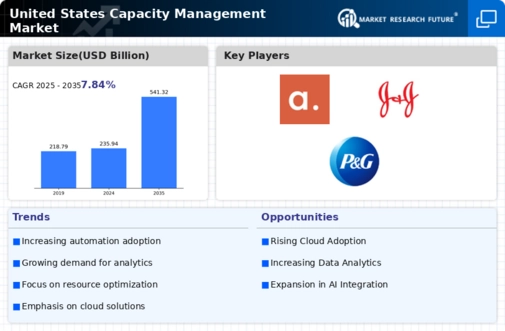Growth of Data Analytics
The proliferation of data analytics tools is transforming the capacity management market. Organizations are leveraging advanced analytics to gain insights into resource utilization and demand forecasting. This trend is particularly pronounced in sectors such as retail and telecommunications, where data-driven decision-making can enhance capacity planning. The market for data analytics is projected to grow by over 25% annually, indicating a strong correlation with the capacity management market. As businesses increasingly rely on data to inform their strategies, the integration of analytics into capacity management practices is likely to become a standard approach.
Focus on Customer Experience
Enhancing customer experience is becoming a pivotal focus for businesses, thereby impacting the capacity management market. Companies are recognizing that effective capacity management directly influences service delivery and customer satisfaction. For instance, in the hospitality sector, optimizing resource allocation can lead to improved guest experiences and increased loyalty. As organizations strive to meet customer expectations, the capacity management market is expected to grow, driven by the need for solutions that facilitate better service delivery and responsiveness to customer demands.
Rising Demand for Efficiency
The capacity management market is experiencing a notable surge in demand for operational efficiency across various sectors. Organizations are increasingly recognizing the need to optimize resource allocation and minimize waste. This trend is particularly evident in industries such as manufacturing and logistics, where the implementation of capacity management solutions can lead to cost reductions of up to 20%. As businesses strive to enhance productivity, the capacity management market is likely to see substantial growth, driven by the necessity for streamlined operations and improved performance metrics.
Regulatory Compliance and Standards
The capacity management market is increasingly shaped by the need for compliance with regulatory standards. Industries such as healthcare and finance are subject to stringent regulations that necessitate effective capacity management practices. Organizations are investing in solutions that ensure adherence to these regulations, which can lead to improved operational transparency and risk mitigation. The financial implications are significant, as non-compliance can result in penalties amounting to millions of dollars. Thus, the focus on regulatory compliance is a critical driver for the capacity management market, compelling businesses to adopt robust management strategies.
Increased Adoption of Cloud Solutions
The shift towards cloud-based solutions is significantly influencing the capacity management market. Companies are migrating their operations to the cloud to leverage scalability and flexibility, which are essential for effective capacity management. According to recent data, approximately 70% of organizations in the US have adopted cloud technologies, facilitating real-time monitoring and management of resources. This transition not only enhances operational agility but also reduces infrastructure costs, thereby propelling the growth of the capacity management market as businesses seek to harness the benefits of cloud computing.














Leave a Comment